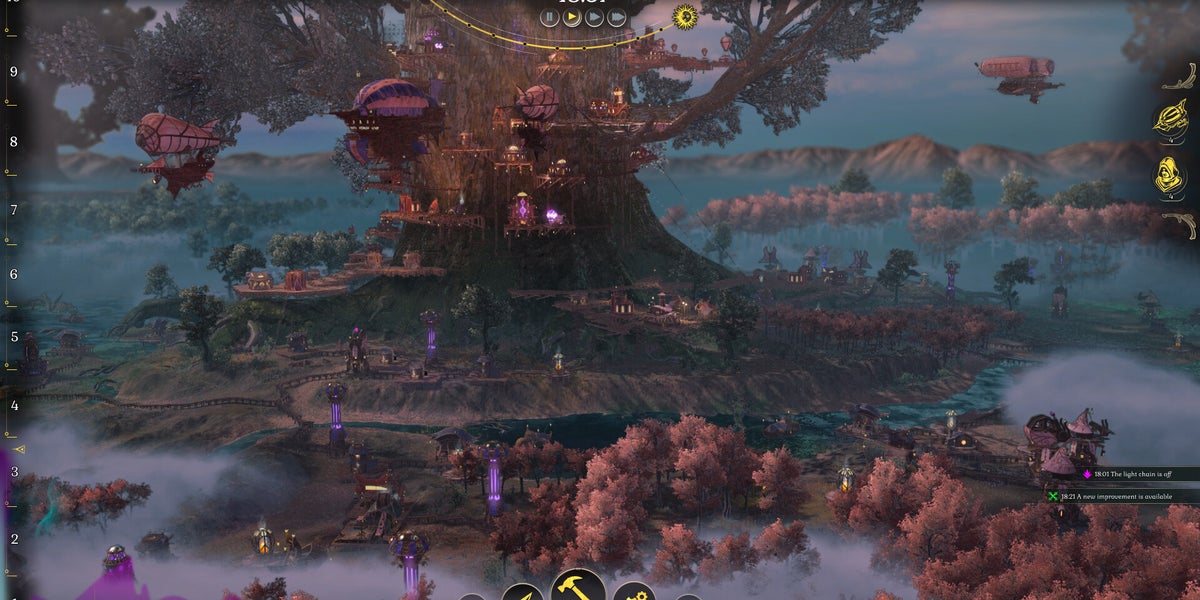
What happens when you mix the eerie genius of Akira Yamaoka with moody, tree-based architecture in a space where light is a rare resource? You get Darkswitch — a haunting yet strangely meditative city-building game that isn’t afraid to lean into the shadows. But don’t let first impressions fool you, because beyond the bleak visuals and ambient dread lies a deeply strategic experience where the environment doesn’t just act; it reacts. And sometimes, punishes.
In today’s saturated world of bright, optimism-infused simulators, Darkswitch stands out for its distinctive tone and uncommon mechanics. But… is it fun? Is it frustrating? Well, maybe both. Let’s explore.
What Is Darkswitch, Really?
Darkswitch is a city-builder with a core twist — instead of sunlight and open plains, you’re designing settlements in a misty, twilight-bound realm of towering trees and creeping fog. Rather than growth through expansion, you often find yourself weighing what to shut down, what to leave behind, and how long your light generators can survive. Players construct tree-based platforms, elevators, and light funnels while battling a spreading gloom threatening to reclaim everything.
The game taps into ecological horror, but in subtle ways. You’re not fighting monsters. Not directly. But you feel watched — a sentiment heightened by Akira Yamaoka’s beautifully twisted soundtrack. If you’ve played Silent Hill, his style feels familiar, though here it’s less overtly terrifying and more… disquieting. Quiet piano motifs trail off into crackling static. Wind passes through broken branches like a sigh. It’s… unnerving.
Yet, there’s something oddly therapeutic about tweaking your settlement layout at midnight, adjusting lumen levels, or salvaging lost light beacons beneath the tree canopy. It’s immersive — in a way that might surprise you.
The Role of Light as a Resource
Unlike traditional city-builders where resources are mostly seen as static values (wood, iron, gold, etc.), light in Darkswitch is alive. You generate it, funnel it, lose it. And worse — sometimes it flickers.
Perhaps the cleverest system in the game is how buildings prioritize power. When the light runs low, systems fail one by one. First, non-essentials dim—gardens, libraries, radios. Then, key infrastructure shuts down. Medical labs. Purifiers. Defense pylons. All in real time. You’re forced to choose: save the hospital or the water tower?
It’s these tough calls that make Darkswitch compelling. You’re not just building a tree colony. You’re triaging an ecosystem always on the brink. And light becomes more than design — it’s survival.
Akira Yamaoka’s Soundtrack Deepens the Experience
We can’t really talk about this game without highlighting the score. It’s not background. It’s part of the narrative.
Yamaoka’s compositions don’t draw attention to themselves immediately. Instead, they bleed into the play space. One moment, a subtle hum drones beneath your construction noises. The next, something shifts in tone. A synth pulses out of time. Dissonance. Then silence. It mirrors your gameplay rhythm — a little chaotic, slightly disjointed, always uncertain.
He described this soundtrack (in a behind-the-scenes interview linked at the bottom) as “quiet violence.” That phrase stuck with me. Because yes, there is violence here — not loud, but atmospheric. The audio design makes it feel like the forest itself grieves every time you disrupt it for progress.
Here’s something that happened to me: during an expansive building phase, I forgot to turn off secondary pylons. Power drained, and the soft ambient track abruptly stopped. What came next wasn’t music, not really — just the sound of wind… and then a single, eerie whistle. It felt like being scolded by the forest. Weird, right?
Building Mechanics: Roots, Platforms, and Vertical Challenge
Most city-builders move horizontally. In Darkswitch, it’s the opposite. Expansion goes upward, or downward — depending on your construction strategy. Settlements are suspended on tree branches, requiring players to factor in weight, balance, and distance from power hubs.
There’s an almost puzzle-like quality to the building grid. Some areas are off-limits due to rot or broken branches. Others allow only certain structures. The challenge is never just “where should this go?” but rather “can I afford to place this here both spatially and energetically?” The tension is real.
You might build a medical wing high in the canopy, only to realize your lifts don’t reach it anymore because a branch cracked under pressure. Now you’re rerouting power, rerouting medics. Players describe Darkswitch as “playing chess with nature.” Honestly, that feels about right.
Environmental Hazards and Day-Night Cycles
Though it’s called a “dark” game, Darkswitch does feature faint cycles — more a suggestion of day than actual light. During brief luminescence periods, you can recharge solar reserves and repair higher-tier structures. Miss those windows… and well, it only gets harder.
Environmental hazards include collapsing tree limbs, fog blooms that disable certain buildings, and migrating lightless zones — places where even artificial illumination fails. These aren’t randomized disasters. They’re gradual, telegraphed — but only if you’re paying attention.
Consider it less like SimCity, and more like a tactical survival sim with long-term planning. You’ll likely lose your first five settlements within the first few cycles. (I did. Repeatedly.) It’s unforgiving — but learning feels rewarding.
Table: Key Features at a Glance
| Feature | Details |
|---|---|
| Main Resource | Light Energy (Lumen Units) |
| Primary Terrain | Vertical Tree Canopy Grid |
| Hazards | Fog Bloom, Structural Decay, Energy Failures |
| Soundtrack | Akira Yamaoka, Original Score |
| Unique Mechanic | Dynamic Light Prioritization and Shutdowns |
Community Reactions and Player Reviews
Surprisingly, despite (or maybe because of) its dark tone, Darkswitch has built a highly passionate fanbase — especially among players tired of overly cheerful sandboxes. On forums like Steam and Reddit, discussions are often philosophical: is light management a metaphor for climate decay? Loss? Emotional burnout?
Still, not everyone enjoys it. Some players criticize it for being “too punishing” or “emotionally draining.” One person said playing Darkswitch made them “want to hug their houseplants and never touch a light switch again.” That sounds dramatic… but after 10 hours, I kind of get it.
It’s not a game you binge. It’s a game you return to when you’re in a certain mood—maybe frustrated by modern noise, maybe seeking stillness. Either way, it leaves a mark.
Q&A: Frequently Asked Questions About Darkswitch
Q1: Is Darkswitch a horror game?
Not exactly. While it uses horror elements in its atmosphere and soundtrack, it’s more of a survival-strategy game with a dark aesthetic.
Q2: How hard is it for new players?
Pretty challenging at first. Expect a learning curve, but once you understand how systems interact, it becomes more manageable — though never truly relaxing.
Q3: Can you “win” the game?
There’s no fixed endgame. Survival for as long as possible is the goal. Some events unfold after reaching certain milestones, but it’s more about endurance than victory.
Q4: What platforms is it available on?
Currently on PC and Steam Deck. Console ports are reportedly in development but undated as of now.
Q5: Is there multiplayer?
No, and honestly, it doesn’t feel like it needs it. The solitude adds to its atmosphere.
Conclusion: Should You Play Darkswitch?
Darkswitch is not your average city-building sim. It casts a long, uncertain shadow — one painted with ambience, vertical design, and the uncanny genius of Akira Yamaoka’s musical moods. If you’re the kind of player who relishes tension, who doesn’t mind failing a few times to learn how systems work, and who loves when a game tries something different at the cost of broad appeal — then yes, this one’s worth your time.
We covered how Darkswitch reimagines city-building by focusing on light as a synthesized yet natural resource. Through a tree-based construction canvas, a dynamic soundtrack, and frequent soft disasters, it pushes players to think vertically and emotionally about sustainability in a virtual world. It’s not always “fun” in a traditional sense — sometimes it’s reflective, possibly even a bit sad. But that’s okay. Not everything needs to be a dopamine loop.
My suggestion? Go in expecting discomfort. Not in gameplay mechanics, but in narrative pacing and decision-making pressure. You don’t collect cute villagers. You preserve faint embers and pray they don’t go out. That subtle sense of tension might not be for everyone, sure. But for those that get it? It becomes unforgettable.
So — are you ready to switch off the lights and build in the dark?
Source: https://www.silenthillchronicle.com, https://store.steampowered.com/app/Darkswitch, https://www.productivity.biz.id


